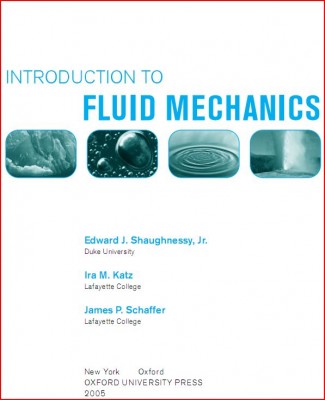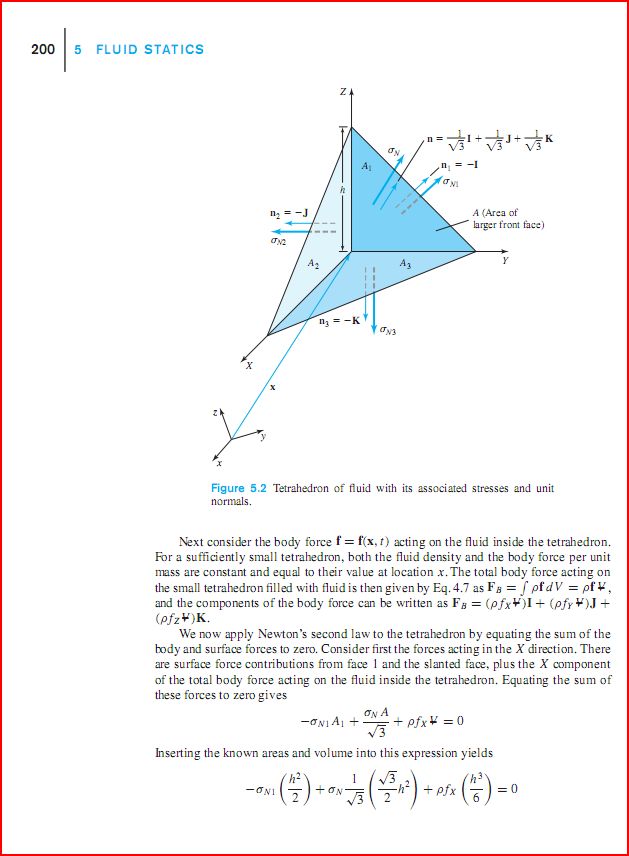Introduction to Fluid Mechanics


Introduction to Fluid Mechanics provides a balanced and uniquely visual treatment of the tools used in solving modern fluid mechanics problems. Presenting an image-intensive approach to fluid dynamics through classic kinematic concepts, the book demonstrates the importance of flow visualization in a framework of modern experimental techniques and flow simulation.Detailed photographs and diagrams of fluid motions and phenomena throughout the text help students to see and understand why equations change drastically for different types of flows. Output illustrations from CFD (computational fluid dynamics) programs illustrate the possibilities of flow behavior, enabling students to concentrate on ideas instead of mathematics. The book also provides the means to solve interesting problems early in the course by presenting case studies at the beginning of the text. These cases are revisited later to reinforce empirical rules and help explain advanced methods of analyzing a flow.Creating a foundation for further study in this important and exciting field, Introduction to Fluid Mechanics is ideal for a first course in fluid mechanics. The book is designed to accommodate students concentrating in mechanical engineering as well as those in the civil, aerospace, and chemical engineering fields
18MB
Download
http://s9.alxa.net/s9/srvs3/01/006/...anics_2005.rar


Introduction to Fluid Mechanics provides a balanced and uniquely visual treatment of the tools used in solving modern fluid mechanics problems. Presenting an image-intensive approach to fluid dynamics through classic kinematic concepts, the book demonstrates the importance of flow visualization in a framework of modern experimental techniques and flow simulation.Detailed photographs and diagrams of fluid motions and phenomena throughout the text help students to see and understand why equations change drastically for different types of flows. Output illustrations from CFD (computational fluid dynamics) programs illustrate the possibilities of flow behavior, enabling students to concentrate on ideas instead of mathematics. The book also provides the means to solve interesting problems early in the course by presenting case studies at the beginning of the text. These cases are revisited later to reinforce empirical rules and help explain advanced methods of analyzing a flow.Creating a foundation for further study in this important and exciting field, Introduction to Fluid Mechanics is ideal for a first course in fluid mechanics. The book is designed to accommodate students concentrating in mechanical engineering as well as those in the civil, aerospace, and chemical engineering fields
PHP Code:
CHAPTER 1
Fundamental Concepts
1.1 Introduction 3
1.2 Gases, Liquids, and Solids 14
1.3 Methods of Description 22
1.3.1 Continuum Hypothesis 23
1.3.2 Continuum and Noncontinuum Descriptions 24
1.3.3 Molecular Description 26
1.3.4 Lagrangian Description 27
1.3.5 Eulerian Description 27
1.3.6 Choice of Description 28
1.4 Dimensions and Unit Systems 29
1.4.1 {MLtT} Systems 30
1.4.2 {FLtT} Systems 31
1.4.3 {FMLtT} Systems 31
1.4.4 Preferred Unit Systems 32
1.4.5 Unit Conversions 33
1.5 Problem Solving 34
1.6 Summary 35
Problems 36
CHAPTER 2
Fluid Properties
2.1 Introduction 43
2.2 Mass, Weight, and Density 43
2.2.1 Specific Weight 48
2.2.2 Specific Gravity 49
2.3 Pressure 51
2.3.1 Pressure Variation in a Stationary Fluid 54
2.3.2 Manometer Readings 57
2.3.3 Buoyancy and Archimedes’ Principle 58
2.3.4 Pressure Variation in a Moving Fluid 60
2.4 Temperature and Other Thermal Properties 64
2.4.1 Specific Heat 65
2.4.2 Coefficient of Thermal Expansion 67
2.5 The Perfect Gas Law 70
2.5.1 Internal Energy, Enthalpy, and Specific
Heats of a Perfect Gas 70
2.5.2 Limits of Applicability 71
2.6 Bulk Compressibility Modulus 73
2.6.1 Speed of Sound 76
2.7 Viscosity 80
2.7.1 Viscous Dissipation 83
2.7.2 Bulk Viscosity 83
2.8 Surface Tension 85
2.8.1 Pressure Jump Across a Curved Interface 87
2.8.2 Contact Angle and Wetting 90
2.8.3 Capillary Action 90
2.9 Fluid Energy 93
2.9.1 Internal Energy 93
2.9.2 Kinetic Energy 94
2.9.3 Potential Energy 95
2.9.4 Total Energy 95
2.10 Summary 97
Problems 99
CHAPTER 3
Case Studies in Fluid Mechanics
3.1 Introduction 103
3.2 Common Dimensionless Groups in Fluid
Mechanics 105
3.3 Case Studies 114
3.3.1 Flow in a Round Pipe 115
3.3.2 Flow Through Area Change 120
3.3.3 Pump and Fan Laws 124
3.3.4 Flat Plate Boundary Layer 128
3.3.5 Drag on Cylinders and Spheres 132
3.3.6 Lift and Drag on Airfoils 137
3.4 Summary 140
Problems 141
CHAPTER 4
Fluid Forces
4.1 Introduction 146
4.2 Classification of Fluid Forces 148
4.3 The Origins of Body and Surface Forces 149
4.4 Body Forces 152
4.5 Surface Forces 160
4.5.1 Flow Over a Flat Plate 171
4.5.2 Flow Through a Round Pipe 173
4.5.3 Lift and Drag 175
4.6 Stress in a Fluid 178
4.7 Force Balance in a Fluid 187
4.8 Summary 190
Problems 191
CHAPTER 5
Fluid Statics
5.1 Introduction 197
5.2 Hydrostatic Stress 199
5.3 Hydrostatic Equation 201
5.3.1 Integral Hydrostatic Equation 202
5.3.2 Differential Hydrostatic Equation 205
5.4 Hydrostatic Pressure Distribution 210
5.4.1 Constant Density Fluid in a Gravity Field 211
5.4.2 Variable Density Fluid in a Gravity Field 218
5.4.3 Constant Density Fluid in Rigid Rotation 222
5.4.4 Constant Density Fluid in Rectilinear Acceleration 229
5.5 Hydrostatic Force 233
5.5.1 Planar Aligned Surface 234
5.5.2 Planar Nonaligned Surface 238
5.5.3 Curved Surface 248
5.6 Hydrostatic Moment 252
5.6.1 Planar Aligned Surface 256
5.6.2 Planar Nonaligned Surface 260
5.7 Resultant Force and Point of Application 267
5.8 Buoyancy and Archimedes’ Principle 269
5.9 Equilibrium and Stability of Immersed Bodies 275
5.10 Summary 278
Problems 280
CHAPTER 6
The Velocity Field and Fluid Transport
6.1 Introduction 299
6.2 The Fluid Velocity Field 300
6.3 Fluid Acceleration 312
6.4 The Substantial Derivative 319
6.5 Classification of Flows 320
6.5.1 One-, Two-, and Three-Dimensional Flow 321
6.5.2 Uniform, Axisymmetric, and Spatially Periodic Flow 327
6.5.3 Fully Developed Flow 331
6.5.4 Steady Flow, Steady Process, and Temporally
Periodic Flow 332
6.6 No-Slip, No-Penetration Boundary Conditions 336
6.7 Fluid Transport 337
6.7.1 Convective Transport 340
6.7.2 Diffusive Transport 348
6.7.3 Total Transport 352
6.8 Average Velocity and Flowrate 358
6.9 Summary 363
Problems 365
CHAPTER 7
Control Volume Analysis
7.1 Introduction 375
7.2 Basic Concepts: System and Control Volume 376
7.3 System and Control Volume Analysis 377
7.4 Reynolds Transport Theorem for a System 381
7.5 Reynolds Transport Theorem for a Control Volume 382
7.6 Control Volume Analysis 385
7.6.1 Mass Balance 386
7.6.2 Momentum Balance 397
7.6.3 Energy Balance 420
7.6.4 Angular Momentum Balance 439
7.7 Summary 450
Problems 452
CHAPTER 8
Flow of an Inviscid Fluid: the Bernoulli Equation
8.1 Introduction 474
8.2 Frictionless Flow Along a Streamline 475
8.3 Bernoulli Equation 477
8.3.1 Bernoulli Equation for an Incompressible Fluid 479
8.3.2 Cavitation 482
8.3.3 Bernoulli Equation for a Compressible Fluid 487
8.4 Static, Dynamic, Stagnation, and Total Pressure 490
8.5 Applications of the Bernoulli Equation 496
8.5.1 Pitot Tube 496
8.5.2 Siphon 503
8.5.3 Sluice Gate 509
8.5.4 Flow through Area Change 511
8.5.5 Draining of a Tank 518
8.6 Relationship to the Energy Equation 521
8.7 Summary 524
Problems 526
CHAPTER 9
Dimensional Analysis and Similitude
9.1 Introduction 534
9.2 Buckingham Pi Theorem 536
9.3 Repeating Variable Method 540
9.4 Similitude and Model Development 549
9.5 Correlation of Experimental Data 554
9.6 Application to Case Studies 557
9.6.1 DA of Flow in a Round Pipe 557
9.6.2 DA of Flow through Area Change 558
9.6.3 DA of Pump and Fan Laws 559
9.6.4 DA of Flat Plate Boundary Layer 561
9.6.5 DA of Drag on Cylinders and Spheres 562
9.6.6 DA of Lift and Drag on Airfoils 562
9.7 Summary 563
Problems 564
DIFFERENTIAL ANALYSIS OF FLOW
CHAPTER 10
Elements of Flow Visualization and Flow Structure
10.1 Introduction 573
10.2 Lagrangian Kinematics 578
10.2.1 Particle Path, Velocity, Acceleration 578
10.2.2 Lagrangian Fluid Properties 589
10.3 The Eulerian–Lagrangian Connection 590
10.4 Material Lines, Surfaces, and Volumes 592
10.5 Pathlines and Streaklines 597
10.6 Streamlines and Streamtubes 603
10.7 Motion and Deformation 607
10.8 Velocity Gradient 612
10.9 Rate of Rotation 619
10.9.1 Vorticity 622
10.9.2 Circulation 628
10.9.3 Irrotational Flow and Velocity Potential 632
10.10 Rate of Expansion 635
10.10.1 Dilation 636
10.10.2 Incompressible Fluid and Incompressible Flow 638
10.10.3 Streamfunction 643
10.11 Rate of Shear Deformation 650
10.12 Summary 653
Problems 654
CHAPTER 11
Governing Equations of Fluid Dynamics
11.1 Introduction 659
11.2 Continuity Equation 660
11.3 Momentum Equation 666
11.4 Constitutive Model for a Newtonian Fluid 671
11.5 Navier–Stokes Equations 678
11.6 Euler Equations 683
11.6.1 Streamline Coordinates 689
11.6.2 Derivation of the Bernoulli Equation 692
11.7 The Energy Equation 699
11.8 Discussion 702
11.8.1 Initial and Boundary Conditions 702
11.8.2 Nondimensionalization 703
11.8.3 Computational Fluid Dynamics (CFD) 706
11.9 Summary 708
Problems 709
CHAPTER 12
Analysis of Incompressible Flow
12.1 Introduction 713
12.2 Steady Viscous Flow 718
12.2.1 Plane Couette Flow 720
12.2.2 Circular Couette Flow 723
12.2.3 Poiseuille Flow Between Parallel Plates 732
12.2.4 Poiseuille Flow in a Pipe 737
12.2.5 Flow over a Cylinder (CFD) 741
12.3 Unsteady Viscous Flow 744
12.3.1 Startup of Plane Couette Flow 749
12.3.2 Unsteady Flow over a Cylinder (CFD) 752
12.4 Turbulent Flow 754
12.4.1 Reynolds Equations 756
12.4.2 Steady Turbulent Flow Between Parallel Plates (CFD) 757
12.5 Inviscid Irrotational Flow 760
12.5.1 Plane Potential Flow 761
12.5.2 Elementary Plane Potential Flows 769
12.5.3 Superposition of Elementary Plane Potential Flows 772
12.5.4 Flow over a Cylinder with Circulation 777
12.6 Summary 780
Problems 782
APPLICATIONS
CHAPTER 13
Flow in Pipes and Ducts
13.1 Introduction 791
13.2 Steady, Fully Developed Flow in a Pipe or Duct 793
13.2.1 Major Head Loss 799
13.2.2 Friction Factor 801
13.2.3 Friction Factors in Laminar Flow 805
13.2.4 Friction Factors in Turbulent Flow 812
13.3 Analysis of Flow in Single Path Pipe and Duct Systems 817
13.3.1 Minor Head Loss 824
13.3.2 Pump and Turbine Head 835
13.3.3 Examples 838
13.4 Analysis of Flow in Multiple Path Pipe and Duct Systems 846
13.5 Elements of Pipe and Duct System Design 851
13.5.1 Pump and Fan Selection 853
13.6 Summary 864
Problems 867
CHAPTER 14
External Flow
14.1 Introduction 882
14.2 Boundary Layers: Basic Concepts 884
14.2.1 Laminar Boundary Layer on a Flat Plate 887
14.2.2 Turbulent Boundary Layer on a Flat Plate 894
14.2.3 Boundary Layer on an Airfoil or Other Body 898
14.3 Drag: Basic Concepts 902
14.4 Drag Coefficients 905
14.4.1 Low Reynolds Number Flow 905
14.4.2 Cylinders 908
14.4.3 Spheres 913
14.4.4 Bluff Bodies 916
14.5 Lift and Drag of Airfoils 926
14.6 Summary 933
Problems 935
CHAPTER 15
Open Channel Flow
15.1 Introduction 942
15.2 Basic Concepts in Open Channel Flow 945
15.3 The Importance of the Froude Number 952
15.3.1 Flow over a Bump or Depression 953
15.3.2 Flow in a Horizontal Channel of Varying Width 961
15.3.3 Propagation of Surface Waves 965
15.3.4 Hydraulic Jump 972
15.4 Energy Conservation in Open Channel Flow 978
15.4.1 Specific Energy 981
15.4.2 Specific Energy Diagrams 986
15.5 Flow in a Channel of Uniform Depth 989
15.5.1 Uniform Flow Examples 994
15.5.2 Optimum Channel Cross Section 999
15.6 Flow in a Channel with Gradually Varying Depth 1003
15.7 Flow Under a Sluice Gate 1003
15.8 Flow Over a Weir 1009
15.9 Summary 1012
Problems 1014
Appendixes
Appendix A Fluid Property Data for Various Fluids A-1
Appendix B Properties of the U.S. Standard Atmosphere B-1
Appendix C Unit Conversion Factors C-1
CREDITS D-1
INDEX I-1
18MB
Download
http://s9.alxa.net/s9/srvs3/01/006/...anics_2005.rar